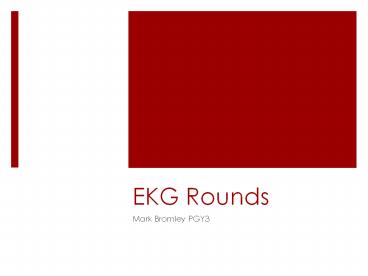EKG Rounds PowerPoint PPT Presentation
1 / 35
Title: EKG Rounds
1
EKG Rounds
- Mark Bromley PGY3
2
Objectives
- Identify classic ECG findings of PE
- Understand the pathophysiologic basis
- Discuss clinical utility
3
What are the Classic Findings of PE on ECG?
4
Case 1
- A 54 year-old man
- Presents with sudden dyspnea
- Hx of recent orthopedic surgery
- OE moderate distress ?dyspnea
- HR115 RR 36 O2 sats 92 BP 165/90
- His exam was unremarkable except for a casted L
leg
5
Case 1
6
Findings
- Tachycardia
- Rightward axis
- S1Q3T3
- Simultanoeus T-wave inversion in inferior
anteroseptal leads - Incomplete RBBB
7
What are the Classic Findings of PE on ECG?
8
Classic ECG Abnormalities
- Sinus Tachycardia
- RV strain pattern
- T wave inversions in V1-V4
- Rightward axis deviation
- Incomplete RBBB
- P pulmonalae
- S1Q3 or S1Q3T3 pattern
- Acute cor pulomnale
- S1Q3T3 pattern, right axis deviation, and RBBB.
9
- These changes, particularly in combination, are
suggestive but not diagnostic of PE - Even pts with massive PE may have only mild,
nonspecific ECG changes
10
In pulmonary embolus,what is the most common
ECG pattern?
11
Normal ECG
- Completely normal
- Sinus rhythm between 60-100 bpm
- Normal conduction
- Normal axis
- Normal P wave, QRS complex, and ST segment/T wave
morphologies - An entirely normal ECG is found in10 to 25
(Panos, 1988 Hubloue, 1996)
12
What is the most common ECG abnormality?
13
Sinus Tachycardia
14
comment on the conduction
15
Right Sided StrainIncomplete RBBB
- ?right-sided heart pressures leads to
?ventricular afterload - Results in ?right-sided myocardial wall tension
- The RV is not able to withstand such pressures
- it rapidly dilates
- ?chamber size and eventual contractile dysfunction
16
Case 2
- 29-year-old woman
- Presents with shortness of breath
- History 8 weeks pregnant
- On exam Visibly distressed
- HR 110 RR 32 O2 Sat 91 on 5 L BP 80/40
17
Case 2
18
Findings
- Rate 120
- Incomplete RBBB
- T wave abnormality
19
29 F 19 weeks gestation. Presents SOB.
20
2 hours later
21
P pulmonalae
- Associated with RA enlargement
- Incidence 2 - 30
22
Case 3
- 69-year-old man
- Presents with shortness of breath
- History of diabetes and hypertension
- On exam Comfortable and alert.
- HR 110 RR 32 O2 Sat 97 on 5 L BP 163/107
- Exam was otherwise unremarkable
23
Case 3
24
Case 3 - findings
- Tachycardia
- R axis deviation
- Incomplete RBBB
- S1Q3T3
- Simultaneous inversion of T waves in Inferior and
anteroseptal leads - p pulmonalae
25
Ischemia and Infarction
- ?CO compromises both systemic and coronary
perfusion - ?wall tension
- Systemic hypotension ?Ischemia and infarction
- As right-sided ventricular dysfunction worsens,
RV infarction and circulatory collapse may occur
26
Right Axis Deviation
- RV enlargement
- Negative deflection of lead I
- Positive deflection of V6
- Left axis deviation more common (related to
underlying dz) - When control for underlying disease equal
incidence
(Nielsen, 1989)
27
McGinn-White Pattern
- S1Q3T3
- First described in 1935 7 pts with massive PE
- Since numerous authors have refuted the
usefulness - Still classically linked to PE
- Q Give a differential diagnosis for S1Q3T3.
- PTx
- Embolism
- AIR, FAT, PE
- Cor pulmonalea
- Severe Pneumonia
- Neoplastic disease
28
Diagnostic value of ECG
- Many studies have been done in patients with
confirmed PE - Diagnostic value of ECG can only be determined by
applying it to patients with suspected PE - then determine if the test is predictive of PE
29
- Pts presenting to ED R/O PE
- ECGs were obtained on 189/212 patients
- analyzed for 28 features thought to be associated
with PE - Only tachycardia and incomplete RBBB were
significantly more frequent in patients with PE
than those without PE - S1Q3T3 ? not predictive
30
Prognosis
- What findings were more frequent in pts with
fatal outcome? - Atrial arrhythmias
- Complete right bundle branch block
- Peripheral low voltage
- Pseudoinfarction pattern (Q waves) in leads III
and aVF - ST?s (?or ?) in left precordial leads
- 29 of pts who exhibited 1 of these
abnormalities did not survive to hospital
discharge - 11 of the patients without a pathological ECG
(Giebel et al., 2005)
31
Take Home Points
- ECG is not a sensitive or specific test for PE
- ECG changes are transient
- Most common ECG finding normal
- Most common ECG abnormality sinus tach
- Value of ECG in PE
- Assessing other etiologies
- Prognostic value
32
References
- Panos R J, Barish RA, Whye DW, et al The
electrocardio- graphic manifestations of
pulmonary embolism. J Emerg Med 1988 6301-7 - Hubloue I, Schoors D, Diltoer M, et al Early
electrocardio- graphic signs in acute massive
pulmonary embolism. Eur J Emerg Med 1996
3199-204 - Akula et al. Right-sided EKG in pulmonary
embolism. Journal of the National Medical
Association (2003). - Nielsen F, Lund O, Ronne K, et al Changing
electrocardio- graphic findings in pulmonary
embolism in relation to vascular ob- struction.
Cardiol 198976274-284 - Geibel et al. Prognostic value of the ECG on
admission in patients with acute major pulmonary
embolism. European Respiratory Journal (2005)
33
Right Sided Chest Leads
- Increase the sensitivity of ECG
- Very small study looked prospectively at 100 pts
- Results
- PE present in 20pts
- Standard ECG - findings present in 80
- Right-sided ECG findings present in 100
- qr or qs in V4R, V5R, V6R, increased sensitivity
(Akula, 2003)
34
Case 4
- 18 year female
- Presents with syncope
- History OCP
- OE looks well
- HR 102 RR 17 BP 120/76 O2 sats 94
- Otherwise unremarkable
35
Case 4

